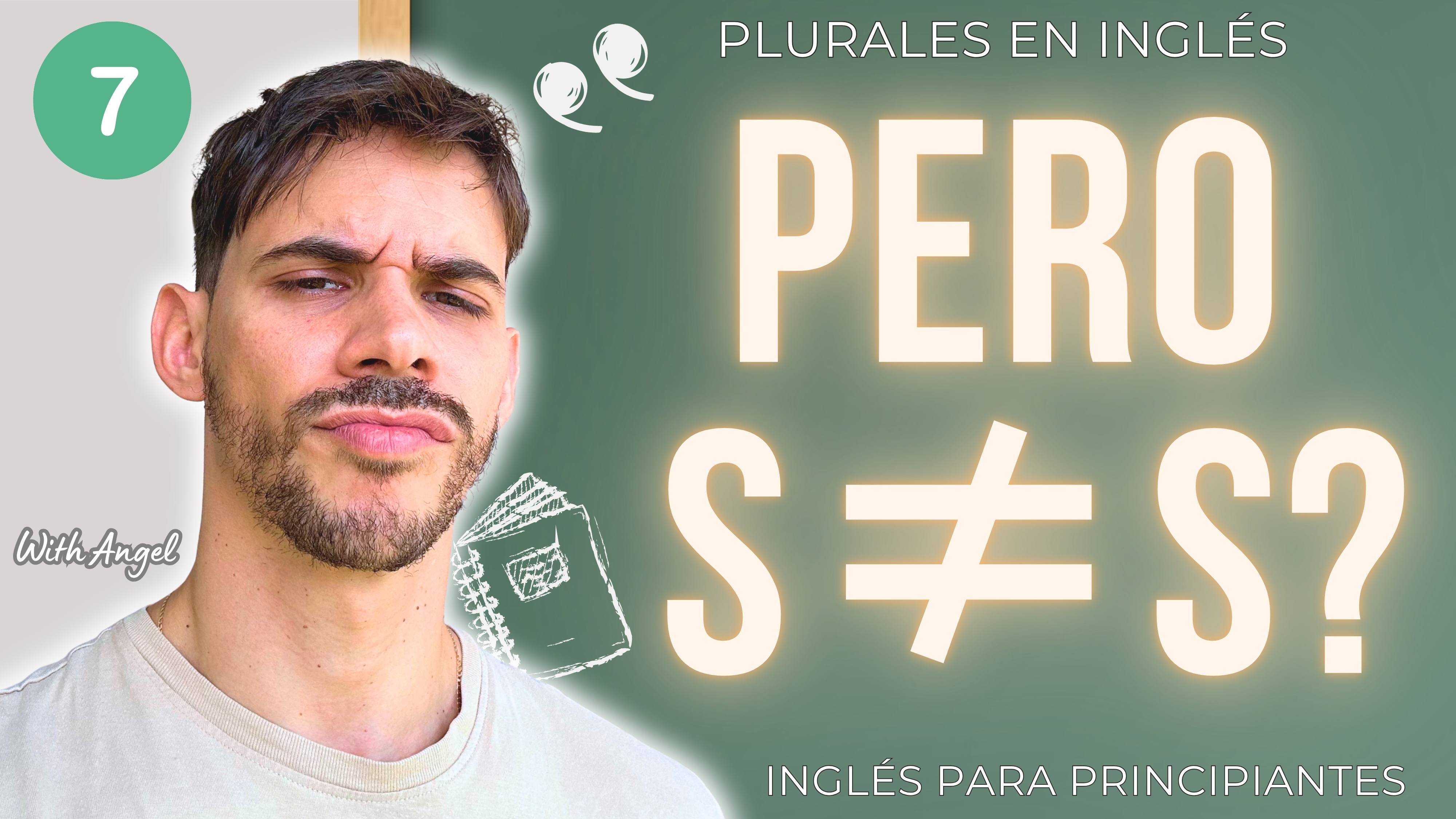🇪🇸 ¡Bienvenido de nuevo a tu curso gratuito de inglés!
En esta lección aprenderás a formar y pronunciar los plurales en inglés correctamente, incluyendo los tres sonidos finales /s/, /z/ y /ɪz/.
📥 Download the Worksheet / Descarga la hoja de trabajo
👉 Download PDF – Lesson 7 Plurals in English
Includes all exercises, the general dialogue, and space for your answers.
Incluye todos los ejercicios, el diálogo integrador y espacio para escribir tus respuestas.
🇺🇸 Welcome back to your free English course!
In this lesson, you’ll learn how to form and pronounce plurals in English correctly — including the three final sounds /s/, /z/ and /ɪz/.
🧩 1. Forming Plurals in English / Formación de plurales
🇺🇸 Most English nouns add -s:
cat → cats
cup → cups
🇪🇸 La mayoría de los sustantivos en inglés forman el plural con -s:
cat → cats (gatos)
cup → cups (tazas)
🇺🇸 Words ending in s, sh, ch, x, z, ge add -es:
bus → buses
watch → watches
🇪🇸 Las palabras que terminan en s, sh, ch, x, z o ge forman el plural agregando -es:
bus → buses (autobuses)
watch → watches (relojes)
🇺🇸 Some are irregular:
man → men
child → children
🇪🇸 Algunos son irregulares:
man → men (hombres)
child → children (niños)
🔊 2. Pronunciation of -S / Pronunciación de -S
🇺🇸 There are three ways to pronounce the final -S:
- /s/ – voiceless, no vibration (cats, cups, rocks)
- /z/ – voiced, vibration (dogs, cars, clouds)
- /ɪz/ – extra syllable after sibilant sounds (buses, watches, messages)
🇪🇸 Hay tres formas de pronunciar la -S final:
- /s/ – sin vibración, como la S en español
- /z/ – con vibración en la garganta
- /ɪz/ – añade una sílaba extra después de sonidos s, sh, ch, x, z o ge
💡 Tip: Touch your throat. If you feel vibration, the plural ends with /z/.
📚 3. Examples and Practice from the Video / Ejemplos del video
cat → cats /s/ 🐱
dog → dogs /z/ 🐶
rock → rocks /s/ 🪨
cloud → clouds /z/ ☁️
message → messages /ɪz/ 💬
🧠 4. Practice Exercises – Lesson 7 / Ejercicios de práctica
✏️ A) Choose the Correct Plural Form / Elige la forma plural correcta
- bus → _____
- car → _____
- watch → _____
- tree → _____
- rock → _____
(Answers: buses, cars, watches, trees, rocks)
🎧 B) Pronunciation Grouping / Agrupa según la pronunciación
| Word | /s/ | /z/ | /ɪz/ |
|---|---|---|---|
| cats | ✅ | ||
| dogs | ✅ | ||
| rocks | ✅ | ||
| cars | ✅ | ||
| watches | ✅ | ||
| messages | ✅ |
🗣️ C) Sentence Completion / Completa las oraciones
- I have two _____ (cat).
- Those _____ (rock) are beautiful.
- The _____ (dog) are playing outside.
- I got many _____ (message) today.
💬 5. General Review Exercise (Lessons 1 – 7) / Ejercicio general de repaso
🇺🇸 Complete the dialogue using what you’ve learned from all lessons so far — introductions, questions, spelling, prepositions, and plurals.
Mia: Hi! What’s your name?
Leo: My name is Leo. What about you?
Mia: I’m Mia. How are you today?
Leo: I’m great! I’m at the park with my friends.
Mia: Nice! Are those your dogs?
Leo: Yes, they’re my dogs. They love trees and rocks!
Mia: Beautiful landscape! Where are your books?
Leo: They’re in my bag. I have two books and two pens.
Mia: Perfect! See you later!
🇪🇸 Completa el diálogo usando lo que has aprendido: presentaciones, preguntas, ortografía, preposiciones y plurales.
(Repite el diálogo y sustituye algunos sustantivos por los tuyos para practicar.)
✅ 6. Key Takeaways / Conclusiones
🇪🇸 Los plurales en inglés: reglas sencillas, pero sonidos engañosos
Formar plurales en inglés es, en apariencia, muy fácil: casi siempre basta con añadir una -s o -es al final del sustantivo. Sin embargo, la verdadera dificultad está en la pronunciación. Aunque en la escritura todos los plurales parecen iguales, no se pronuncian igual. Dependiendo del sonido final de la palabra, el plural se pronuncia de tres maneras distintas: /s/, /z/ o /ɪz/. Comprender estas diferencias y practicarlas en voz alta es fundamental para sonar más natural y fluido.
Veamos cómo funciona cada caso:
- /s/ – Se usa cuando la palabra termina con un sonido sordo, es decir, cuando las cuerdas vocales no vibran. Ejemplos:
- cats → /kæts/
- books → /bʊks/
- cups → /kʌps/
Si colocas tus dedos sobre la garganta al pronunciar cat o book, notarás que no hay vibración. En estos casos, el plural termina con un sonido /s/, sin voz.
- /z/ – Este sonido se usa cuando la palabra termina con un sonido sonoro, es decir, cuando las cuerdas vocales sí vibran. Ejemplos:
- dogs → /dɔːɡz/
- pens → /penz/
- tables → /ˈteɪbəlz/
Si al decir la palabra sientes vibración en la garganta, entonces el plural debe llevar el sonido /z/. Así la palabra fluye mejor y suena más natural.
- /ɪz/ – Este sonido aparece cuando la palabra termina con un sonido silbante o zumbante, como /s/, /z/, /ʃ/, /ʒ/, /tʃ/ o /dʒ/. Ejemplos:
- buses → /ˈbʌsɪz/
- dishes → /ˈdɪʃɪz/
- bridges → /ˈbrɪdʒɪz/
Aquí, el sonido /ɪz/ ayuda a separar el plural del resto de la palabra para que resulte más fácil de pronunciar.
👉 Consejo: No te limites a leer las reglas. Pronuncia en voz alta. Escúchate, repite, y compara con hablantes nativos. Di los pares en singular y plural (book/books, dog/dogs, bus/buses) y presta atención a cómo cambia el sonido final. La práctica constante es la clave para mejorar tu pronunciación y sentirte más cómodo al hablar.
✅ In summary:
Spelling plurals in English is easy, but mastering the sounds takes practice. Focus on the difference between voicedand voiceless endings, and pay attention to those special /ɪz/ cases. With time, these pronunciation rules will become second nature.
🇺🇸 Plurals in English: Simple Rules, but Tricky Sounds
Forming plurals in English is usually quite simple — in most cases, you just add -s or -es to the end of a noun. However, pronunciation is where many learners find challenges. The plural ending may look the same in writing, but it doesn’t sound the same in speech. Depending on the final sound of the word, the plural ending can be pronounced in three different ways: /s/, /z/, or /ɪz/. Understanding these patterns and practicing them out loud is essential for sounding natural and fluent.
Let’s explore how each ending works:
- /s/ – This sound occurs when the noun ends in a voiceless sound, meaning your vocal cords do not vibrate. For example:
- cats → /kæts/
- books → /bʊks/
- cups → /kʌps/
If you put your fingers on your throat while saying these words, you’ll notice there’s no vibration on the last sound. That’s a voiceless ending, so the plural adds a clean, unvoiced /s/ sound.
- /z/ – This sound is used when the noun ends in a voiced sound, meaning your vocal cords do vibrate. Examples include:
- dogs → /dɔːɡz/
- pens → /penz/
- tables → /ˈteɪbəlz/
Try the same vibration test — if your throat vibrates when you pronounce the final sound of the singular form, you’ll add a voiced /z/ sound for the plural. This makes the pronunciation smoother and more natural in connected speech.
- /ɪz/ – Finally, this sound appears when the noun ends in a sibilant sound, that is, a sound that already includes a hissing or buzzing noise such as /s/, /z/, /ʃ/, /ʒ/, /tʃ/, or /dʒ/. Examples:
- buses → /ˈbʌsɪz/
- dishes → /ˈdɪʃɪz/
- bridges → /ˈbrɪdʒɪz/
Adding /ɪz/ helps separate the plural ending from the word itself and makes pronunciation easier.
👉 Tip for learners: Don’t just read about these rules — say them out loud! Repetition and listening are key. Record yourself saying singular and plural pairs like book/books, dog/dogs, bus/buses, and listen carefully to the differences. The more you practice, the more automatic these sounds become. You can even practice in front of a mirror or along with pronunciation videos to make sure your mouth and tongue move naturally.
📥 Download the Worksheet / Descarga la hoja de trabajo
👉 Download PDF – Lesson 7 Plurals in English
Includes all exercises, the general dialogue, and space for your answers.
Incluye todos los ejercicios, el diálogo integrador y espacio para escribir tus respuestas.
🔖 Hashtags
#InglésDesdeCero #CursoDeInglésGratis #FluentMinds #Lección7 #PluralesEnInglés #PronunciaciónInglés #InglésParaLatinos #InglésParaCubanos #LearnEnglish #EnglishCourse #InglésFácil #InglésConÁngel #FluentMindsPodcast #ESL #InglésOnline #InglésParaPrincipiantes #InglésParaHispanos

